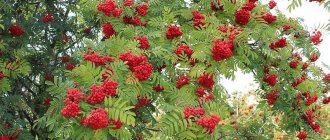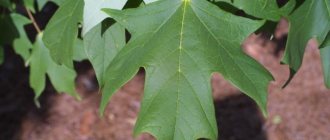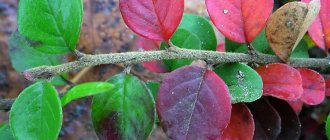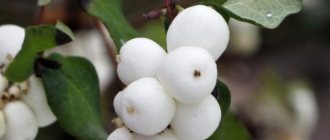Walnut is a plant widely known throughout the world, surprisingly beneficial for humans. Its wood is a valuable species of wood and is used in the production of furniture and interior decoration items.
But the main thing for which this southern culture is valued is its fruits. The walnut, which is actually considered a drupe and not a nut, has a special recognizable taste of the kernel, has a beneficial effect on human health, and is an excellent substitute for meat, fish and dairy products.
Thanks to this amazing combination of both beneficial and tasteful qualities, nut kernels are widely used in cooking, eaten simply raw, and sometimes included in folk recipes for the treatment of certain diseases.
True, these are not all the secrets associated with this ancient plant. Our article will tell you about all the most interesting and useful things.
Walnut - botanical description
Walnut Walnut
is a shrubby or woody variety of plants reaching up to 25 meters in height. Typically, a tree has a developed and extensive crown and an equally developed root system for active consumption of moisture from the soil. However, in the northern areas of its growth, due to lack of heat, it can stop at a height of 1-2 meters (for example, in the Leningrad region, in Scandinavia).
The trunk is usually covered with hard gray bark. Wood is a valuable type of wood for furniture production and other needs.
The leaves of the walnut are complex and can consist of 3-5 oval leaves fused into a single plate. They bloom simultaneously with flowering. The length usually does not exceed 6-7 cm.
The flowers grow in pendant catkins and are formed on each plant of strictly one sex. Staminate flowers differ from pistillate flowers. Pollination occurs by wind or insects. Flowering time usually occurs in late spring.
The plant produces fruits – drupes. They have a dense green pericarp (dries out and bursts when ripe), inside it there is a strong oval or round stone. The seed is covered with a strong woody shell, which does not open on its own. Inside the seed are edible kernels.
Fruiting in the wild begins no earlier than after 10-12 years. However, the plant itself grows for up to 300-400 years, actively bearing fruit all this time. When caring for a tree, the first harvests can be harvested already 6-7 years from the moment of planting.
Where it all begins
Let's see how to do everything correctly. Features of cultivation: to plant seeds in spring, three months will require germination or stratification.
With this intention, at home they take a box with wet sand and stick the knuckles in, then transfer it to the cold, where the temperature is +5 - for example, to the cellar. After a month, take it out to air and soak the base.
Seeds are placed in water 3-5 days before planting. In the fall, gardeners do not often plant; they prefer to plant in May.
Distribution area and homeland of the plant
Young tree
It is believed that the walnut spread throughout the world from the territory of the Middle Eastern countries and the territories of modern Central Asia. But today the plant is found in the wild or as an agricultural crop grown for its fruits in vast areas of the temperate, subtropical and tropical zones.
Most often, trees or shrubs can be found in the north and central parts of China, India, Iran, Kazakhstan, all countries of southern and central Europe, the Caucasus and southern regions of Russia, the USA and even a narrow belt covering the southern borders of Canada. Walnut also grows in limited areas in northern Africa, in a number of countries in South America and in Australia. The northernmost recorded growing point is Norway and Sweden.
Some relict plantings are still preserved in areas of Kyrgyzstan that are difficult for humans to reach, as well as in the mountains of Turkmenistan.
Walnuts grow in rich, humus-rich, moist soils. Due to the extremely developed root system, the tree is able to survive long periods of drought, but with the arrival of rains it quickly replenishes its reserves.
Almond
Almonds are a distant relative of plums; they belong to the same genus. In the wild, it lives on rocky soils that are rich in calcium. It often grows on mountain slopes, climbing to heights of up to 2500 m.
This is a branched tree or bush with narrow leaves with a sharp apex. Almond flowers bloom before the leaves appear. They reach 2.5 cm in diameter, the petals are white or pink, and there are decorative double forms.
Flowering lasts up to 2 weeks, in warm regions already in February. At this time, the tree is very vulnerable to frost. In general, almonds are quite frost-resistant; they tolerate frosts down to -25 degrees. A well-developed branched root system allows the plant to survive without water for a long time.
In place of the flowers, dry, velvety, pubescent oval drupes with a leathery, inedible shell are formed, which from a botanical point of view are not nuts. This is a stone fruit.
Cultivated almonds have a sweet kernel, which cannot be said about wild species. Their bitter seeds contain the glycoside amygdalin. When broken down, it forms poisonous hydrocyanic acid with a characteristic odor.
Almonds are used in cooking more often than other nuts; they go well with any type of dough. There are many desserts in which almonds are the main ingredient. From them you can prepare milk, which is a substitute for cow's milk, and valuable edible oil.
Important! With regular consumption of almonds, the composition of the intestinal microbiome improves; it has an anti-aging effect, slowing down skin aging.
Classification
Today, people know at least 21 varieties of walnuts. Most cultivated trees are classified according to different characteristic qualities. The most famous thing is the quality of the fruit. Highlight:
- Top grade.
- First grade.
- Second grade.
There is a classification according to the size of the kernels:
- Halves.
- Quarters.
- Pieces.
- Debris.
From the point of view of a cultivated plant, there is a division according to:
- Early maturation.
- Medium maturing.
- Late ripening.
In addition, it is customary to divide all varieties according to expected yield. For example, low-yielding varieties bring 25-50 kg. from a bush/tree. The most valuable varieties can produce up to 300 kg per season. fruits, and in rare cases even more.
Nutritional value and composition
Walnut kernels
Surely many people know very well that walnuts (and all nuts in particular) are a high-calorie product. Purified kernels are rich in fat content, and thanks to carbohydrates they perfectly satisfy hunger. For this reason, it is recommended to include nuts in your diet for weight loss, but this should be done in moderation.
The average calorie content is only 100 grams. kernels range from 630 to 670 Kcal. This is roughly comparable to a whole liter of non-skimmed domestic cow's milk!
REFERENCE. One walnut fruit contains approximately 60-80 kcal.
Nutritional value of walnuts per 100 g:
- Fats – 62.8 g. (about 78% of the daily value for humans).
- Proteins – 15.2 g. (19% Daily Value).
- Carbohydrates – 10.1 g. (2-3%).
- Fiber – 6.1 g. (thirty%).
- Water – 3.8 g.
- Ash – 2 gr.
Despite the fact that nuts can rightfully be considered a fatty food (this can be seen from the energy composition), they are extremely beneficial for humans due to the balanced content of micro- and macroelements, as well as groups of essential vitamins.
Walnuts contain:
- phosphorus;
- magnesium;
- sodium;
- calcium;
- potassium;
- sulfur;
- iron;
- zinc;
- fluorine;
- selenium;
- copper;
- cobalt;
- manganese;
- iodine.
Vitamins:
- A;
- B;
- C;
- PP;
- E;
The composition contains essential amino acids: phenylalanine, tryptophan, histicide, leucine, lysine, etc.
However, consume more than 500 grams. cores per day is highly not recommended. The optimal daily intake for a person should be limited to 100-150 grams. – this is approximately 6-8 whole fruits without shell.
Hazelnut
The hazel genus has about 20 species. But only forms that produce large fruits are called hazelnuts. Their habitat is Western Asia and Europe.
These are deciduous shrubs and sometimes trees. Their leaves are broadly oval, quite large in size, lighter on the underside, and the central vein is pubescent. There are also red-leaved forms. The fruits - nuts - are formed from female flowers, which are located in pairs in the axils of the bracts. Compared to hazel, the fruits are larger and the hard shell surrounding the core is thinner. Thanks to selection, many varieties with high yields have appeared.
All parts of a hazelnut are used:
- tea from the leaves is drunk as a diuretic;
- A yellow pigment is extracted from the bark and is used to dye leather;
- the wood is used to make small-sized carpentry crafts; it is hard, but at the same time easy to process;
- The branches are suitable for weaving baskets and other products.
Hazelnuts are decorative and are often used in landscape design.
But the main value of the plant is its nuts. This is a high-calorie product (100 g of kernels contains more than 600 kcal). Therefore, you should not get carried away with nuts, especially for those who are watching their figure. According to nutritionists, the daily norm should be about 40 g.
Of all the vitamins necessary for humans, hazelnuts only lack D and B12. Even 40 g of kernels contains almost the daily requirement of vitamin E.
Important! In order for the nuts to bring the most benefits, it is better to eat them before 16 hours, without first frying them.
Read: 28 of the most exotic fruits, vegetables and berries from around the world
Varieties
Walnut, as a cultivated plant, is grown almost all over the world. Naturally, in different places they prefer to use different varieties. Some produce more yield, some have strong immunity, and some are characterized by resistance to frost and early ripening of fruits, which is important in the northern regions.
- Graceful is a mid-season walnut variety, very popular in the southern regions of Russia and Ukraine due to its high-quality harvest, but patient attitude to the vagaries of the weather. The variety easily survives drought, irregular watering, and can also withstand mild frosts. It bears fruit within 5 years after planting and has good immunity. During the season it gives up to 15-20 kg. harvest from the tree.
- Harvest is the most popular variety in the temperate zone of Russia and Belarus due to its resistance to cold, as well as consistently high yields (from 25 kg per tree, depending on the quality of care). It grows up to 6 meters in height, has an abundant, spreading crown. The first harvests begin to be produced within four years after planting. It is believed that the fruitful variety can take root on any soil.
For Russia and Belarus, the most suitable varieties can be identified: Chernovetsky-1, Bukovinsky-1, Aurora, Urozhainy and some others. In the southern regions - Krasnodar Territory, the Caucasus, Crimea and southern Ukraine - classic southern varieties of walnuts are grown. Popular varieties: Zarya Vostoka, Dessertny, Krasnodarets, Pelan, etc.
Cedar
There are two inaccuracies in the name pine nut: this product is the seeds, and not of cedar, since they are inedible, but of several types of cedar pines:
- European;
- Siberian;
- Korean;
- cedar dwarf.
All of them grow in different regions of Russia. These are majestic coniferous trees 40-60 m high. The only exception is dwarf cedar - its branches spread along the ground, rising to a height of no more than 50 cm. It lives in regions with a harsh climate. An abundant harvest of cones occurs every 3-10 years. They mature within 14-15 months, and sometimes up to 3 years. The size of the cones varies slightly among different species, but the seeds are almost the same:
- weight - about 0.25 g;
- length - from 7 to 9 mm.
Under the hard dark shell lies a delicate, oily, light kernel.
Pine nuts are one of the highest in calories due to their high fat content - 68.4%, but it is mainly represented by unsaturated fatty acids. Their shelf life is short - in purified form no more than 3 months, preferably in the refrigerator. In the shell - six months.
The reason for this is the rapid oxidation of fatty acids. Stale nuts can lead to poisoning. The peeled fruits and nuts of the Mediterranean pine, a relative of cedar pines, are stored even shorter: no more than 2 weeks. But this does not prevent the widespread use of pinoli (the Italian name for pine seeds) in cooking. Among all pine trees, its seeds are the largest - up to 2 cm in length.
There are other pines that produce edible nuts:
- Gerard pine - grows in the Himalayas;
- Colorado pine - lives in North America;
- Mexican pine.
Read: 24 types of dried fruits - the most delicious and most healthy
Features of care and agricultural technology
Walnut can be called a rather capricious tree. The thing is that it requires virtually no care only in natural growing conditions - in the south, where it is always warm and humid. In any other area you will have to take care of the nut.
- Firstly, you need to carefully choose a place on the site: there should be a lot of sun, a minimum of shade and preferably good protection from the wind. It is best to plant the nut as far south as possible, as far as the site allows.
- Walnut loves high-quality and rich soil composition . It follows that the crop needs to be fed frequently. Use nitrogenous fertilizers every year, and periodically prepare the tree for wintering with potassium and phosphorus mixtures.
- Also, you should not infringe on the walnut in watering. The plant loves moist soil .
- For uniform distribution of heat and light, it is necessary to form a crown , annually cutting off the shoots in the upper part.
Considering the fact that walnuts begin to bear fruit late, annual tree care can be called extremely difficult. To some extent, you definitely need to have a fair amount of gardening experience under your belt. This is the only way to independently grow harvests of such healthy and tasty fruits.
Diseases and pests
Objectively speaking, walnuts are often sick or affected by various pests. This is especially true for climates where the tree is not very comfortable - for example, in the middle zone, at the northern border of its distribution.
Among the diseases are:
- Bacteriosis is a disease that affects leaves, shoots, buds, flowers, ovaries and, if nothing is done, fruits. The affected areas first become covered with small black spots until they dry completely. The pathogen easily survives the winter in the buds and under the bark of a tree. Bacteriosis can be treated with Bordeaux mixture according to a prescription.
- Fire blight is spread by wind and insects. This disease affects almost all areas of the tree with watery cankers and can lead to the death of the entire walnut. Treatment requires drugs with a high copper content.
- White or brown spot are similar viral diseases that appear as dry spots on all plant tissues. The affected areas dry out and die. A solution of Bordeaux mixture is suitable for treatment.
- Root cancer is, unfortunately, an almost incurable disease. As it progresses, large thickenings form on the roots. The plant stops growing, bearing fruit and soon dies completely. Medications containing copper may help.
Pests that have chosen walnuts:
- The American white moth is an extremely dangerous and common pest of walnuts throughout the world. One or two treatments will practically not help, since the individual produces several offspring per year (each - up to 1500 eggs). The most dangerous pests are caterpillars (the most voracious), although larvae (overwinter in the bark) and adult butterflies (feed on leaves and bark along with caterpillars) also cause damage. In the fight you will have to rely on powerful biological products.
- The king walnut moth is a pest that spoils walnut fruits. Adults feed on green matter. Strong pesticides will help in the fight.
- The gall mite is an insect that starts in high humidity. It is very difficult to remove, as it can hide in tissues and tree bark. Harmful to leaves, fruits, trunk, young shoots.
- Sapwood is a small beetle and its larvae, the damage from which can be seen when it is already too late. The insect practically does not come to the surface, but lives in numerous passages, which it gnaws in the trunk and bark of the walnut.
- Aphids can be said to be a classic pest, which is dangerous due to its huge populations and amazing gluttony.
Most diseases can be cured, or at least part of the plant can be saved. Proven and well-studied remedies also help against pests. However, the basis for hardening and developing strong immunity in a walnut is proper, careful and sensitive care on the part of humans.
Inedible
The description ends with inedible species. Internal use of such fruits is dangerous for humans and has side effects. However, the benefits are invaluable when creating important medicines for economic purposes.
Chilibukha
The medicinal drug strychnine is extracted from the tropical seed. A potent medicine tones the nervous system, stimulates the heart and metabolism, but is extremely toxic. Dispensed strictly according to prescription.
Betel
Aborigines chew Areca palm nuts for euphoria, which ends in mouth and throat cancer. The cause is the betel nut alkaloid arecoline, a drug with psychoactive effects. Pharmacologists based on betel nut have created an effective anthelmintic drug.
Soap Nut
Saponins (30%) of tropical sapindus drupes, when combined with water, produce abundant foam. This determines their use for body washing and laundry. Disinfectant components treat the skin and repel insects.
When do walnuts ripen?
Like many plants, walnuts also have early-ripening, mid-ripening and late-ripening varieties.
In general, one can imagine the ripening time of nut fruits from mid-August to the very end of November.
Much depends on the climatic conditions and weather in a particular year. However, this plant is heat-loving.
A natural sign of fruit ripening is the cracking of the shell and its falling from the branches.
Ripe nut
Approximate harvest dates by region:
- Central Russia: September – October.
- Ukraine: August – October.
- Caucasus: September – early October.
- Krasnodar region, Crimea: late September – early October.
The fruits in these regions finally ripen approximately 2-3 weeks before harvest.
Seychellois
Lodoicea maldives is endemic to the Seychelles. This relict palm produces the largest seeds, which are called Seychelles nuts, otherwise known as coco de mer. Mature nuts can weigh more than 25 kg and reach a meter in girth.
Their unusual shape resembles a woman's buttocks or a double coconut. The fruits ripen for a long time - from 7 to 10 years, and the palm tree begins to bear fruit at the age of twenty-five.
Seychelles nuts were credited with amazing healing properties; in the Middle Ages they were considered a cure for all diseases.
Under the hard woody shell, two fingers thick, the nut beginning to ripen contains a jelly-like substance with a pleasant, slightly sweet taste. After some time it hardens and becomes like ivory. The pulp is added to various dishes, cocktails and beer are made from it.
Not everyone can try it - you will have to pay for a permit to export the nut, and the nut itself is not cheap. Local residents make crafts from the shells, which are eagerly snapped up by tourists.
How to store fruits?
There are several ways to store walnuts.
The first of them is to simply leave the collected fruits in a dry and cool place . It is first necessary to sort the entire harvest and leave only the strongest, undamaged nuts for storage. The temperature is suitable within the range from -10 to +20С, and air humidity should not exceed 72%. No sun rays needed. In this state, nuts can be stored for up to a year.
If walnut fruits are frozen, they can last up to one and a half years.
Finally, the still green fruits are crushed and used to make jam and its subsequent canning. This way you can store the product even for more than one year.
What to consider when choosing
Planting material is prepared and high-quality seed is selected. We take it from this year's harvest. Old ones do not germinate well, so ask your summer residents. For excellent results, do not purchase from a nut in the store, but assemble it yourself.
Recommendations for selection:
- Check that the raw materials are intact and without chips. It is unacceptable to have mold.
- Be able to feel the weight in your hand. A very light bone product, this is a sign of drying out of the core.
- Holes on the upper shell are evidence of damage to the inside by parasites.
To grow successfully, look for ones that are ripe with a fine rind and great flavor. By choosing more fruits, we will achieve better fruiting.
Beneficial features
It has long been studied that walnuts have a beneficial effect on many body systems. True, we are talking about moderate consumption of the product (up to 100-150 grams per day).
Basically, the positive effect is ensured by the rich mineral and vitamin composition of the nut kernels and the partitions inside the shell (although they taste bitter, they are also eaten).
INTERESTING. Some nationalities call the walnut “the tree of life.”
In general, the influence of walnuts on improving human health is extensive:
- Walnut kernels will be useful for replacing radionuclides in the body - it’s all about the iodine they contain, which is necessary for the thyroid gland.
- A whole group of vitamins (A, B, C, PP, E, K) will be useful for vitamin deficiency.
- Nuts are included in diets to a limited extent - they contain the same amount of protein as meat and more than milk.
- Cobalt and iron salts in the nuclei strengthen the heart muscle and normalize the composition and quality of blood.
- Crushed shells are useful for hypertension, and a decoction of partitions will improve immunity.
- Walnut kernels will help men: with prostatitis, adenoma. In combination with goat's milk they can be used to improve potency.
- For pregnant women, adding walnuts to the menu will increase immunity, satisfy hunger, increase hemoglobin in the blood, and relieve headaches.
- Walnut oil is used in cosmetology to moisturize the skin and improve hair condition.
However, there are body conditions or diseases that can be aggravated by eating walnuts or products containing them.
Contraindications and who should not eat walnuts?
One of the reasons for moderate consumption of walnuts is the strong allergic reaction to this product - mainly to the protein it contains. In the most acute attacks, even suffocation may occur.
Nut kernels also irritate the mucous membrane, so they can aggravate the condition of a person suffering from a stomach ulcer, duodenal ulcer, gastritis or colitis.
Nuts are contraindicated for constipation, as the fats in the composition will only worsen the condition.
Muscat
In appearance, the nutmeg kernel is similar to a walnut. But they use it differently: they grind it and use it as a spice for any dish: sweet or salty. It's hard to find a product whose taste it couldn't improve.
The habitat of the evergreen fragrant nutmeg, which produces fruits called nutmeg, is the Banda Islands, part of Indonesia. It was from there that valuable spice was imported to Europe. Nutmeg is now grown not only in Indonesia, but also in India, Grenada, Sri Lanka and the Caribbean.
An evergreen tree with smooth leathery leaves blooms for the first time in its sixth year. In place of small flowers of light yellow color, collected in umbrellas of 20 pieces, round fruits up to 9 cm long are formed. They are yellow and look like apricots.
After ripening, the fruits burst, exposing a large stone with a reddish color. After drying, it is also used as a spice. The stone contains an ovoid core up to 3 cm long, gray-brown in color with winding veins that are clearly visible on the cut.
The larger the nut, the more essential oils it contains. Their number is also determined by the dark spots on the surface in which they are contained.
Important! A single dose of more than 30 g has a hallucinogenic and psychotropic effect, and can sometimes even be fatal.
Read: types of fish that are tasty and healthy
Use in cooking
Walnuts are used in cooking in the cuisines of different countries. But dishes with it are most widespread among Asian peoples. The fact is that there the trees on which walnuts grow are very common.
The nuts themselves are valued for their range of flavors. Dishes are prepared from unripe nuts, which have a sour taste, or ripened fruits with tart, slightly sweet notes. Even walnut shell partitions are used - they can add a slight bitterness to dishes. The nut oil made from the kernels is also valued, as it has a traditional mild nutty taste and smell.
Green walnut fruits are mainly used to make jam. Their main value is their high content of vitamin C. By the way, as they ripen, the concentration of the vitamin drops significantly.
The kernels are very widely used in the preparation of desserts: cakes, pastries, ice cream, cocktails, sweets. They perfectly complement baked goods. In the East it is widely used for preparing traditional national dishes: churchkhela, Turkish delight, baklava, sherbet, kozinak, halva.
Crumbs from the kernels or bitter shell partitions are used as a topping for meat and fish dishes. But they can be baked together with other ingredients - it all depends on the recipe.
Walnuts are found in some recipes for first courses: soups, okroshkas or porridges.
The kernels themselves or the oil from them in some cuisines is used to prepare dressings: pesto, bazhi, garo, satsivi sauces.
Walnuts are widely used in one of the best cuisines in the world - in France. There, the product is used in recipes for preparing almost any dish, from entrees to desserts. The kernels are even used in some cheese recipes.
THIS IS INTERESTING. It’s hard to imagine, but walnuts are even used to prepare alcoholic (tinctures, ratafia (sweet vodka), liqueur, cognac) and non-alcoholic drinks (jelly, compote).
Manchurian
The Manchurian walnut has a spreading openwork crown, somewhat reminiscent of a palm tree. The tree can grow up to 28 m in height. Flowering occurs in May, nuts ripen from August to October.
The habitat of the Manchurian walnut is China, the Far East, and the Korean Peninsula. Its special decorativeness and rapid growth have become the reason for its widespread spread to other territories.
This is the closest relative of the walnut, which is why their fruits are similar. The nutritional value is not much different. But the shell of the Manchurian nut is much thicker, and there are many partitions inside. Therefore, it is difficult to obtain the kernel, and its yield is small - no more than 19% of the total weight. Nuts are eaten fresh and used in cooking.
Important! The leaves of the tree secrete a lot of phytoncides that repel insects.
Interesting facts and beliefs
- One may mistakenly believe that walnuts are so named because they spread throughout the world from Greece. But actually it is not. The true distribution area of the tree is Asia. From there they were brought to Greece, and only then the Greeks sold the fruits in the cities of the Slavs. Hence the name “Greek” - that is, “from the Greeks”. In the world and in Russia, the names “Volosh” or “royal” are still common.
- In Central Asia it is still believed that walnuts do not bloom. On the contrary, according to legend, death awaits anyone who sees this tree blooming.
- In Ancient Babylon, one of the cradles of civilization, they believed that eating walnuts could make you wiser (since the kernels resemble the human brain). Therefore, the fruits of this tree were forbidden to be eaten by the lower strata of society.
- Since ancient times, eastern peoples have revered walnut trees. The traditions have been preserved to this day. For example, in the Caucasus you can find hundred-year-old trees. And the oldest walnuts known to man are about 400 years old!
- The walnut tree is characterized by high productivity. It is estimated that on average about 300 kg can be collected during the year in the south. fruits from every tree.
- From a botanical point of view, walnut fruits are drupes.
- It's hard to believe, but only 400 gr. walnuts satisfy the entire daily food requirement of the average person. In this case, we are talking not only about calorie content, but also about the balance of essential minerals, micro- and macroelements.
- However, nutritionists do not recommend consuming more than 100-150 grams per day. walnut. Such solid foods can seriously irritate the mucous membranes of the mouth and throat, and also cause headaches.
- Walnut is one of the most high-calorie foods consumed by humans. Total 100 gr. kernels are comparable to 300 gr. wheat bread, approximately 700 gr. raw potatoes or 1 liter of fresh cow's milk.
- Milky ripe nuts (just beginning to ripen on the tree) can contain up to 100 mg. vitamin C. And this is with a total fetal weight of only 10-15 grams!
- Commercially available open and crushed walnut kernels retain a minimum of their beneficial qualities. It is better to buy whole fruits and open them yourself.
- In order for the eaten walnut to bring maximum benefit, it must be chewed thoroughly. Only in an extremely crushed state are the kernels well absorbed by the body.
- The proteins contained in walnut kernels are comparable to those found in meat or dairy foods. However, thanks to a special substance in the composition - lysine - they are absorbed by the body easier and faster.
- When digesting nuts, the body does not release uric acid, which means no salts are deposited.
- Burnt and crushed walnut shells are a natural component of activated carbon.
Fruit content
Courtship begins in spring. Care includes pruning branches, which is done until mid-March. This is how the crown is formed and diseased branches are cut off. Removal of excess branches is done before sap flows. If there was not enough snow, then the tree is flooded. At the same time, preventive measures are taken against all kinds of insects and diseases; it is recommended to dilute 3% copper sulfate. In addition, they are whitened with lime.
On warm days, it is recommended to sprinkle ammonium nitrate for nutrition. Adult trees over 3 years old receive 6 kg of this substance per year. On dry, hot days, the green space is watered occasionally. At this time of year, fungicides are used to combat midges or fungi.
In July, it is recommended to speed up growth by pinching individual hazel shoots. Watch a detailed video about this.











